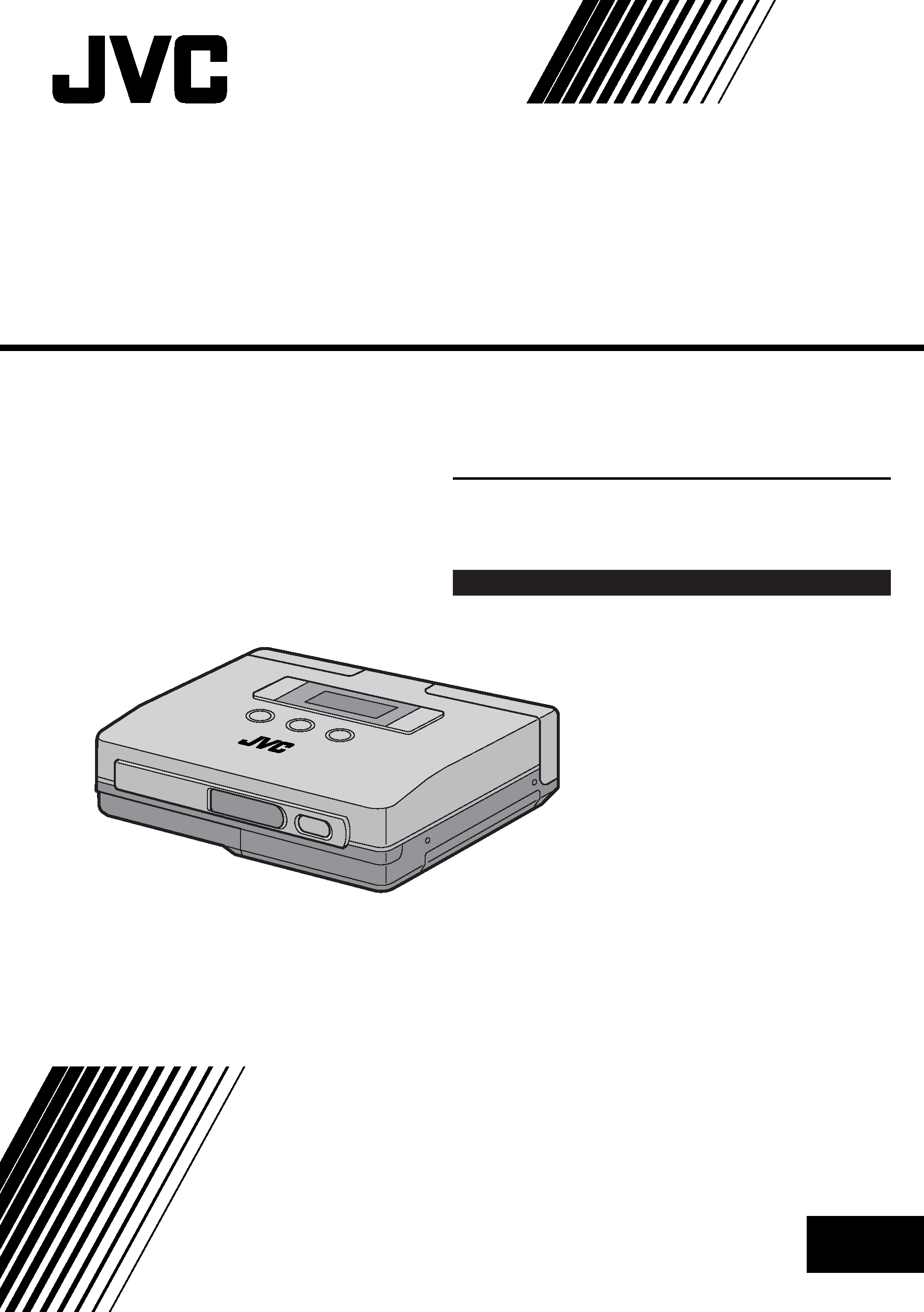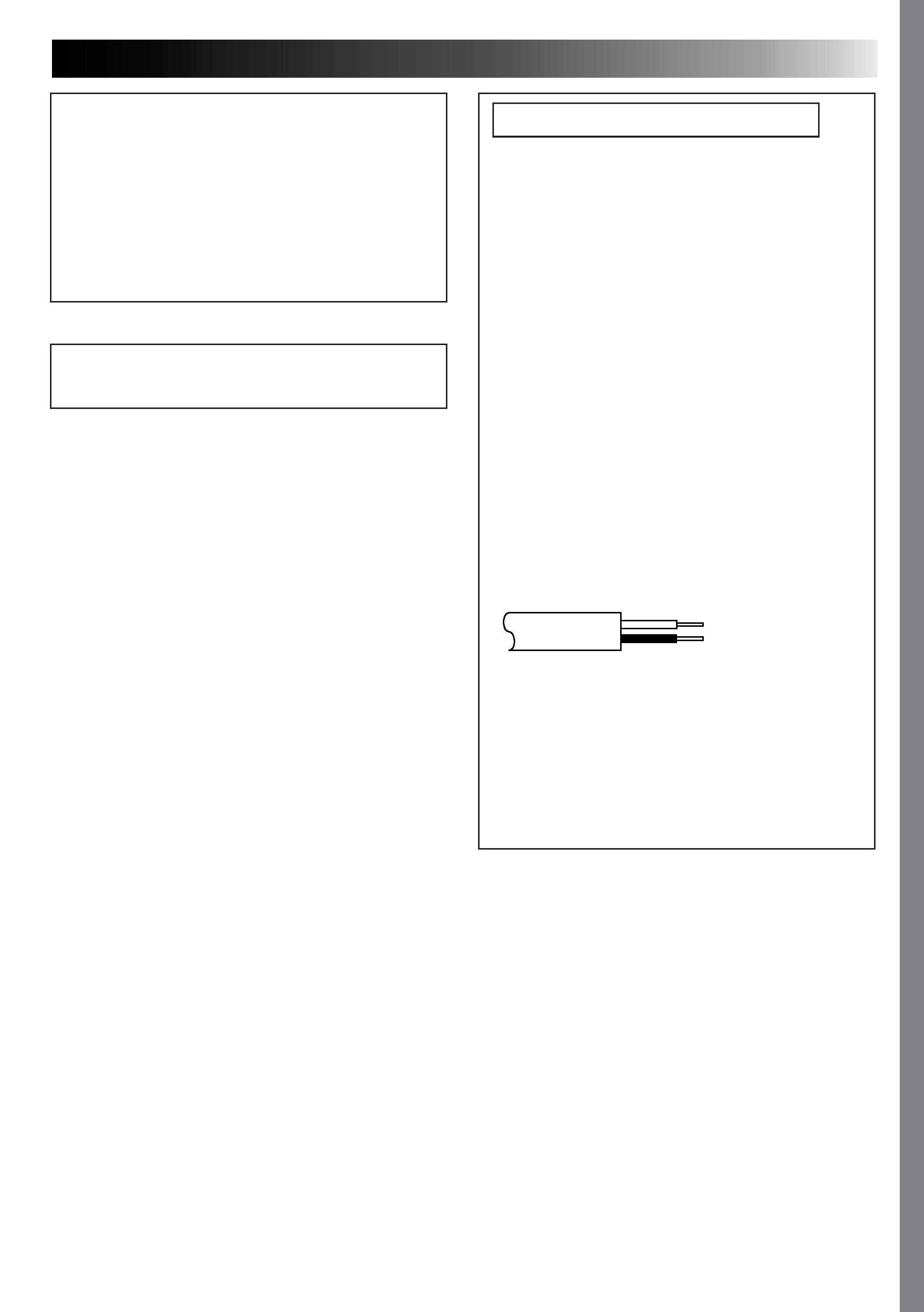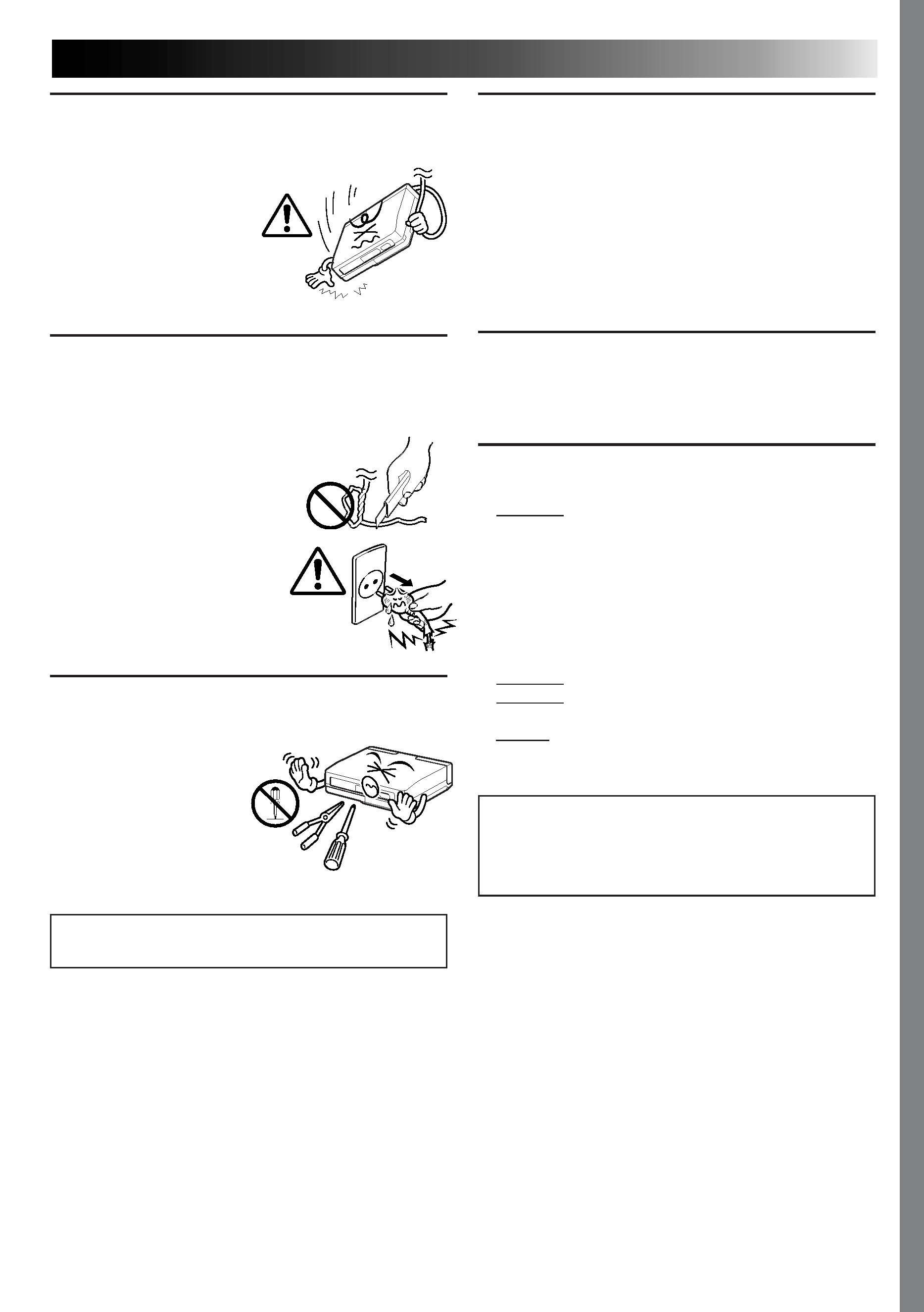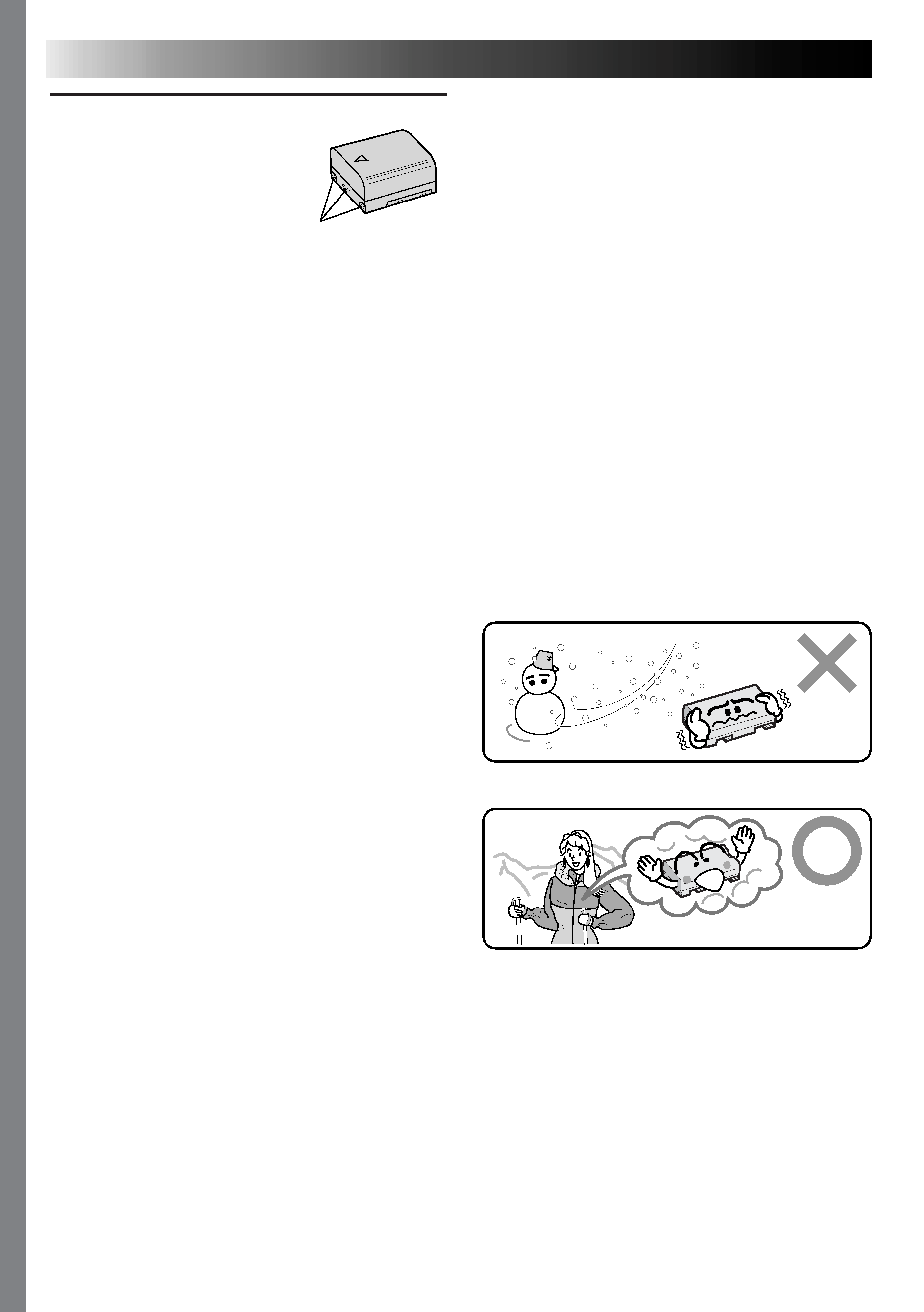
GV-HT1
MINI VIDEO PRINTER
LYT0140-001A
INSTRUCTIONS
ENGLISH
EN
Please visit our CyberCam Homepage on
the World Wide Web and answer our Con-
sumer Survey (in English only):
http://www.jvc-victor.co.jp/index-e.html

EN
1
IMPORTANT (for U. K. owners)
Connection to the mains supply in the United
Kingdom.
DO NOT cut off the mains plug from this
equipment. If the plug fitted is not suitable for
the power points in your home or the cable is
too short to reach a power point, then obtain a
proper safety approved extension lead/adapter
or consult your dealer.
BE SURE to replace the fuse only with an
identical approved type, as originally fitted,
and to replace the fuse cover.
If nonetheless the mains plug is cut off remove
the fuse and dispose of the plug immediately,
to avoid a possible shock hazard by inadvert-
ent connection to the mains supply.
If this product is not supplied fitted with a
mains plug then follow the instructions given
below:
DO NOT make any connection to the Larger
Terminal coded E or Green.
The wires in the mains lead are coloured in
accordance with the following code:
If these colours do not correspond with the
terminal identifications of your plug, connect
as follows:
Blue wire to terminal coded N (Neutral) or
coloured Black.
Brown wire to terminal coded L (Live) or
coloured Red.
If in doubt -- consult a competent electrician.
Brown to L (Live) or
Red
Blue to N (Neutral) or
Black
This unit is produced to comply with Standard
IEC Publ. 65.
This printer is designed to be used with PAL-
type colour television signals. It cannot be used
for monitoring with a television of a different
standard. Use the BN-V607 battery pack and,
to recharge it, the optional multi-voltage AC
Power Adapter/Charger. (An appropriate
conversion adapter may be necessary to
accommodate different designs of AC outlets in
different countries.)

2 EN
Some Do's And Don'ts On The Safe
Use Of Equipment
This equipment has been designed and manufactured to meet international safety standards
but, like any electrical equipment, care must be taken if you are to obtain the best results and
safety is to be assured.
DO read the operating instructions before you attempt to use the equipment.
DO ensure that all electrical connections (including the mains plug, extension leads and
interconnections between pieces of equipment) are properly made and in accordance with
the manufacturer's instructions. Switch off and withdraw the mains plug when making or
changing connections.
DO consult your dealer if you are ever in doubt about the installation, operation or safety of
your equipment.
DO be careful with glass panels or doors on equipment.
DON'T continue to operate the equipment if you are in any doubt about it working normally,
or if it is damanged in any way -- switch off, withdraw the mains plug and consult
your dealer.
DON'T remove any fixed cover as this may expose dangerous voltages.
DON'T leave equipment switched on when it is unattended unless it is specifically stated that it
is designed for unattended operation or has a standby mode. Switch off using the
switch on the equipment and make sure that your family knows how to do this. Special
arrangements may need to be made for infirm or handicapped people.
DON'T use equipment such as personal stereos or radios so that you are distracted from the
requirements of road safety. It is illegal to watch television whilst driving.
DON'T listen to headphones at high volume, as such use can permanently damage your
hearing.
DON'T obstruct the ventilation of the equipment, for example with curtains or soft furnishings.
Overheating will cause damage and shorten the life of the equipment.
DON'T use makeshift stands and NEVER fix legs with wood screws -- to ensure complete
safety always fit the manufacturer's approved stand or legs with the fixings provided
according to the instructions.
DON'T allow electrical equipment to be exposed to rain or moisture.
ABOVE ALL...
-- NEVER let anyone especially children push anything into holes, slots or any other
opening in the case -- this could result in a fatal electrical shock;
-- NEVER guess or take chances with electrical equipment of any kind -- it is better to be
safe than sorry!

EN
3
CAUTIONS
ABOUT THERMAL HEADS
· The thermal heads, necessary for printing, are located
within the unit. The heads can become extremely
warm. To prevent possible burns and injuries, do not
touch the thermal heads.
· When the printer is used for extended periods, the
thermal heads experience wear and tear just like VCR
heads. As the thermal heads become worn, print
quality will gradually decrease. When you notice a
decline in quality, it is possible that the heads may
need to be replaced. Consult your JVC dealer.
DUST
Due to dust or lint adhering to print paper, or to
extreme variations in temperature, a small degree of
colour smearing or lines may be visible in prints.
Failure to heed the following precautions may
result in damage to the printer.
1. DO NOT place the printer . . .
... in an environment prone to extreme temperatures
or humidity.
... in direct sunlight.
... in a dusty environment.
... in an environment where strong magnetic fields
are generated.
... on a surface that is unstable or subject to
vibration.
2. DO NOT place heavy objects on the printer.
3. DO NOT place anything which might spill on top of
the printer.
4. AVOID violent shocks to the printer during
transport.
CAUTION:
Changes or modifications not approved by JVC
could void user's authority to operate the
equipment.
Exercise caution when moving the printer. If you
drop the unit, do not attempt to use it. If during use
you notice that the cabinet
is damaged, shut the
printer down, remove
power supply unit it and
contact your JVC dealer.
Use of the printer under
these conditions can lead
to fire or electric shock.
DO NOT place heavy objects on the AC power
adapters cords, or leave the cord near any heat-
generating appliance, as this can damage the cords.
Avoid excessive pulling or twisting of the power
cords. If the power cords
becomes cut or otherwise
damaged, contact your JVC
dealer. When unplugging the
AC power adapter, DO NOT
pull on the cord. Hold the
plug itself and remove it from
the AC outlet. Use of the
printer with a damaged power
cord can lead to fire, electric
shock and unit malfunctions.
DO NOT remove the cover and attempt to repair or
modify the printer. There are high-voltage
components within the
unit, and the risk of
electric shock and unit
malfunctions exists. If a
problem occurs, contact
your JVC dealer.
Illustrations of this printer may differ slightly
from production models.

4 EN
CAUTIONS
About Batteries
DANGER! Do not attempt to take the batteries
apart, or expose them to flame or excessive heat, as
there is a risk of fire or explosion.
WARNING! Do not allow the battery terminals, or
the battery itself, to come in contact with metals, as
this can result in a short circuit and possibly start a
fire.
The Benefits Of Lithium-Ion Batteries
Lithium-ion battery packs are small but possess a
large power capacity. However, when the battery
pack becomes cool in an environment subject to
cold temperatures (below 10°C), the battery pack
has a characteristic that its usage time becomes
shorter and may cease to function. If this happens,
place the battery pack in your pocket or other
warm, protected place for a short time, then re-
attach it to the camcorder. As long as the battery
pack itself is not cold, it should not affect perform-
ance.
(If you're using some kind of heating pad, make
sure the battery pack does not come in direct
contact with the pad.)
Lithium-ion is vulnerable in colder temperatures.
Battery Packs
The supplied battery pack is a
lithium-ion battery. Before
using the supplied battery pack
or an optional battery pack, be
sure to read the following
cautions:
<Depleting the batteries completely>
1. Turn on the power.
2. Set "save mode" to "off" and remove the batteries
when the power is automatically turned off.
1. To avoid hazard . . .
.... do not burn.
.... do not short-circuit the terminals.
.... do not modify or disassemble.
.... do not expose the battery to temperatures
exceeding 60°C, as this may cause the
battery to overheat, explode or catch fire.
.... use only specified chargers.
2. To prevent damage and prolong service life . . .
.... do not subject to unnecessary shock.
.... charge in an environment where tempera-
tures are within the tolerances shown in the
chart below. This is a chemical reaction type
battery--cooler temperatures impede
chemical reaction, while warmer tempera-
tures can prevent complete charging.
.... store in a cool, dry place. Extended exposure
to high temperatures will increase natural
discharge and shorten service life.
.... fully charge and then fully discharge the
battery once a year when storing the battery
pack over a long period time.
.... remove from charger or powered unit when
not in use, as some machines use current
even when switched off.
NOTES:
It is normal for the battery pack to be warm after
charging, or after use.
Temperature Range Specifications
Charging ................................ 10°C to 35°C
Operation .............................. 0°C to 40°C
Storage .................................. 10°C to 30°C
Recharging time is based on room temperature of
20°C.
The lower the temperature, the longer recharging
takes.
Terminals
